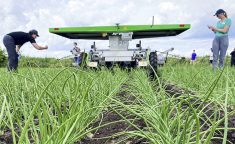Glacier FarmMedia – Most farmers in southern Ontario grow soybeans and corn. Meanwhile, the typical farmer in Saskatchewan produces canola, wheat, barley and probably a pulse crop.
Yet the two share similar concerns about adopting agriculture technology.
Why it matters: Precision tools are becoming increasingly important to efficient, sustainable farming, yet many producers remain concerned about cost vs. return.
A University of Guelph survey found that many growers, regardless of geography, aren’t sure if precision agriculture technology is right for their farm, for the same reasons.
Read Also

Packer buys Green Giant, Le Sieur veg brands from U.S. owner
A Quebec-based processor’s deal to buy the Green Giant and Le Sieur packaged and frozen vegetable brands in Canada from a U.S. owner clarifies the status of two popular retail brands grown by Canadian farmers.
“A lot of (the concerns) relate to cost and having a value from the technology,” said Nicholas Bannon, a University of Guelph agricultural economics student. “(Plus) a lot of these technologies… generate huge amounts of data. And it can be difficult to interpret. Why invest in that technology if they don’t know how to accurately interpret the data?”
In the summer of 2019, Bannon and Sean Mitchell, who just graduated from the agriculture economics program at Guelph, surveyed agriculture retailers in Ontario and Western Canada about the adoption of precision ag, which includes things like drones, sensors, field maps and crop imagery.
To gather the information, they e-mailed crop input retailers who are members of the Ontario Agri Business Association or the Canadian Association of Agri-Retailers.
They contacted ag-retailers because farmers are “surveyed to death,” said Alfons Weersink, an agriculture economics professor at the U of Guelph. As well, many retailers provide custom farming services, so they have a good sense of the market for agriculture techology.
The Ontario Ministry of Agriculture provided a grant to study precision agriculture because the province is interested in the benefits of the technology.
“The general perception is … this is a win-win technology,” Weersink said. “Farmers are going to profit because they can tailor the rates… and the environmental losses will be less.”
One of the questions, posed to the ag retailers, was about barriers to adoption.
What’s preventing their customers from using precision ag tools and services?
Why aren’t producers trying the new technologies so they can apply fertilizer and pesticides in a precise and efficient manner across their fields?
On the Prairies and in Ontario, the No. 1 one barrier was farm income. About 70 per cent of western Canadian respondents said farmers are interested in the technology but “pressure on farm income limits their use,” a report summarizing the survey said.
In Ontario, 53 per cent of retailers identified farm income as a barrier.
“Regardless of the net benefits, low crop prices will slow the adoption of new technologies,” the report noted.
In Ontario and the Prairies, many ag-retailers said farmers aren’t sold on the value of precision ag technologies and services.
About 42 to 44 per cent agreed that farmer perception of the cost being greater than the benefit received is a major barrier to adoption.
Further down the list, the No. 4 barrier was time.
On the Prairies, 36 per cent of ag-retailers agreed that interpreting and making decisions from the precision ag data requires too much of their customers’ time.
“Where you see it really used is when there is high-value crop. Then it’s worth taking the time to make sure the value of that information is worth the cost,” Weersink said.
“What technologies do we see highly adopted that are precision agriculture related? GPS guidance systems, yield monitors. There’s little (time) cost to the producer associated with that and there is great value…. This other stuff is more complex and it takes time.”
The students also surveyed the crop input retailers about custom ag services, where a farmer hires someone to spray a pesticide or apply fertilizer.
Ontario farmers, it turns out, use custom services more often than prairie producers.
“An average of 39 percent of fertilizer and crop protection product sales are custom applied in Ontario, compared to 19 percent in the Prairies,” Mitchell, Bannon and Weersink wrote in a survey report. “Custom application services are an essential part of agricultural input dealers’ operations in Ontario but are not nearly as critical to the success of dealerships in the prairie provinces.”
Several factors may explain why custom services are less common in Western Canada:
- Prairie farms are bigger, so producers can afford their own sprayer and other equipment.
- The growing season is shorter. Producers can’t wait for a custom operator to show up with a sprayer if the wheat crop needs an immediate fungicide application.
Weersink and the University of Guelph students will continue their research into precision ag and farmer adoption, including the value of precision ag data.
This article was originally published at The Western Producer.












